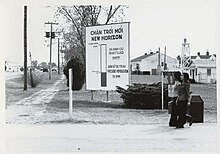Vietnamese Americans
[8] Today, over half of Vietnamese Americans reside in California and Texas, particularly in metropolitan areas like Los Angeles, Houston, and San Jose.[22] Following resettlement preparations, they were assigned to voluntary agencies (VOLAGs), which provided assistance in securing financial and personal support from sponsors in the U.S.[23][24] Most first-wave refugees were better educated, wealthier, and more proficient in English than those in subsequent waves.[25][23] According to 1975 U.S. State Department data, over 30% of first-wave household heads were medical professionals or technical managers, 16.9% worked in transportation, and 11.7% held clerical or sales jobs in Vietnam.[26] The resettlement of South Vietnamese refugees in the U.S. initially faced mixed reception, fueled by fears of job competition, welfare strain, and cultural concerns.[27] Despite initial public reluctance, President Gerald Ford emphasized a "profound moral obligation" to assist the refugees,[28] calling it a "great human tragedy."[29] In response, Congress passed the Indochina Migration and Refugee Assistance Act of 1975, providing special entry status and $455 million in resettlement aid.[38][37][39] The boat people were often rescued up by foreign ships and transported to asylum camps in Hong Kong and Southeast Asia such as Thailand, Malaysia, Singapore, Indonesia, and the Philippines.[40][41] In 1979, the United Nations High Commissioner for Refugees (UNHCR) established the Orderly Departure Program (ODP) to facilitate legal emigration from Vietnam to the U.S. and other countries.[43] However, progress eventually stalled due to disagreements over priorities, as the U.S. focused on specific groups such as Amerasian children and re-education camp prisoners, while Vietnam prioritized the exodus of ethnic Chinese.[44] The Vietnamese Fishermen's Association, with the aid of the Southern Poverty Law Center, won a 1981 antitrust suit against the Klan, disbanding the "private army of white supremacists.Prior to 1998, the majority of Vietnamese green card holders were granted LPR status on humanitarian grounds, such as through refugee or asylum programs.In contrast, Vietnamese employs different pronouns depending on factors like the person's age, gender (anh or chị), and relationship (bạn, cậu, or mày).There are 150 to 165 Vietnamese Buddhist temples in the United States, with most observing a mixture of Pure Land (Tịnh Độ Tông) and Zen (Thiền) doctrines and practices.[81] Vietnamese Americans opened restaurants to preserve traditions and support families, introducing iconic dishes like phở, bánh mì, and gỏi cuốn, which have since become widely popular and embraced across the country.[101] Many older, first-generation Vietnamese American refugees who fled communist rule after the Vietnam War exhibit strong patriotism toward the United States, support for the military, and anti-communist views that often align with the Republican Party.[103][104][105] The party's vocal anti-communism appealed to those who resettled during the Reagan administration and has continued to resonate with many since 2016, particularly due to Donald Trump's anti-China rhetoric.[110] In contrast, younger Vietnamese Americans lean Democratic, marking a generational shift from the Republican preferences of older immigrants who fled communism.[101] The younger generation's political preferences are shaped by exposure to diverse viewpoints, including those on economic policy, healthcare, and social justice, which encourage a shift toward progressive values.[116] The flag's display during the Capitol riot disappointed many Vietnamese Americans, particularly younger generations, who denounced its association "with hate, with racism, with supremacy."[117] They argued that "the ideas of authoritarianism, of overturning the people's will, are not the principles that this flag stands for,"[118] and expressed feeling embarrassed by the incident, saying it made them "looked like clowns."[118][119] Amid this controversy, Congresswoman Stephanie Murphy, the first Vietnamese American woman elected to Congress, served on the January 6th Committee, where she co-led a public hearing and contributed to the investigation of the attack on the U.S.[26] As many are refugees from South Vietnam, many are strongly opposed to communism; this attitude could also take root during and after the Indochina Wars, injustice in reeducation camps as well as other issues with the communist government.In 1999, opposition to a video-store owner in Westminster, California who displayed the flag of Vietnam and a photo of Ho Chi Minh peaked when 15,000 people held a nighttime vigil in front of the store;[133] this raised free speech issues.Many Amerasians were ignored by their American parent; in Vietnam, the fatherless children of foreign men were called con lai ("mixed race") or the pejorative bụi đời ("dust of life").









Los AngelesOrange CountySan Francisco Bay AreaSan JoseSacramento, CaliforniaGreater HoustonDallas-Fort WorthPortland, OregonTwin Cities metropolitan areaWashington metropolitan areaNorthern VirginiaMarylandSeattle areaSan Diego CountyMetro AtlantaNorth CarolinaGreensboroRaleighCharlotteGreater New OrleansGreater BostonPhiladelphia areaNew York CityDenverChicagolandHonoluluGreater OrlandoothersVietnameseEnglishBuddhismChristianityUnaffiliatedVietnamese folk religionCaodaismHòa HảoVietnamese peopleOverseas VietnameseVietnamese CanadiansVietnamese AustraliansAsian AmericansChinese AmericansHmong AmericansAmericansUnited StatesSouth VietnameseVietnam WarCaliforniaHoustonHo Chi MinhOffice of Immigration Statisticslawful permanent residentFall of SaigonSouth VietnamUSS Durham (LKA-114)PhilippinesCamp PendletonFort ChaffeeEglin Air Force BaseFort Indiantown GapVOLAGsU.S. State Departmentmedical professionalsGerald FordIndochina Migration and Refugee Assistance Actethnic enclavesboat peoplere-education campsHong KongThailandMalaysiaSingaporeIndonesiaRefugee Act of 1980United Nations High Commissioner for RefugeesOrderly Departure ProgramAmerasianre-education campGulf CoastKu Klux KlanSouthern Poverty Law Centergreen cardfamily reunificationU.S. Census BureauWashington StateFloridaVirginiaGeorgiaMassachusettsOrangeSanta ClaraHarris CountyenclaveLittle SaigonWestminsterGarden GroveAmerican Community SurveyAsian Garden Mallemployment rateVietnamese language in the United StatesSpanishChineseTagalogtonal languagesyllablediacriticspronounsBuddhistChristianMuslimRoman CatholicsMahayana BuddhismTaoismConfucianismanimist practicesancestor venerationChinese folk religionAmerican CatholicsPure LandThich Thien-AnThich Nhat HanhChua Buu Monbánh mìgỏi cuốnGarlic noodlesHuy Fong sriracha sauce